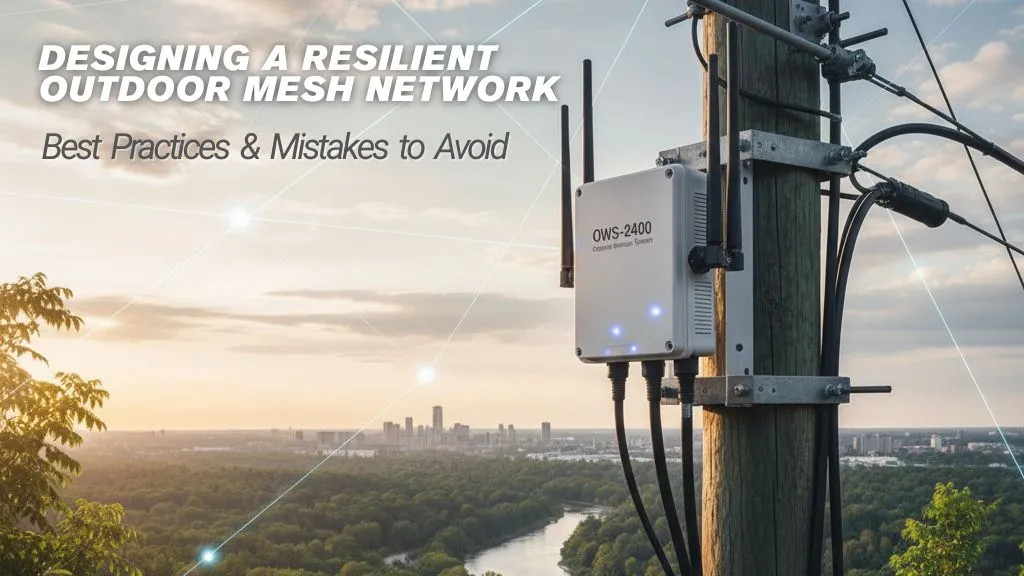In today’s connected world, uninterrupted communication is critical — whether for city surveillance, smart infrastructure, or enterprise operations. Outdoor mesh networks are the backbone of these systems, enabling real-time data flow even in complex and harsh environments. However, building a resilient outdoor mesh network requires more than just placing a few nodes; it demands careful planning, design, and execution.
Let’s explore the best practices for creating a robust outdoor mesh network — and the common mistakes you should avoid to ensure maximum uptime and performance.
1. Start with a Clear Network Design and Coverage Plan
A successful deployment begins with a detailed design blueprint. Map your coverage area, identify potential obstructions (buildings, trees, terrain), and plan optimal node placement. The goal is to maintain line-of-sight where possible while minimizing interference.
Using high-performance mesh equipment like the OWS-2400 Outdoor Wireless System ensures strong connectivity and adaptive routing between nodes. A well-planned mesh layout reduces latency, packet loss, and dead zones — essential for mission-critical applications such as video surveillance or public WiFi.
2. Prioritize Redundancy and Multi-Path Connectivity
Redundancy is at the heart of resilience. A mesh network should be designed so that if one node fails, traffic automatically reroutes through another. Multi-radio, multi-channel devices provide greater flexibility, allowing simultaneous connections across different frequencies.
Ensure your network topology supports self-healing — meaning it can reconfigure automatically when a link drops. This not only improves uptime but also simplifies maintenance and scalability.
3. Choose Rugged Hardware for Outdoor Conditions
Outdoor environments can be unpredictable — heat, rain, dust, and wind can degrade equipment over time. Select hardware built for such extremes: weatherproof enclosures, corrosion-resistant mounts, and surge protection are must-haves.
Industrial-grade mesh nodes like the OWS-2400 Outdoor Wireless System are specifically engineered for these scenarios. They combine durability with high throughput, ensuring continuous connectivity even in demanding climates.
4. Optimize for Low Latency and High Throughput
In applications such as CCTV monitoring, industrial automation, or smart traffic control, latency can make or break performance. Use equipment that supports multiple radios and intelligent channel management to minimize delay.
Keep hops between nodes minimal — typically three or fewer — to maintain stable performance. Also, deploy QoS (Quality of Service) settings to prioritize critical data like video feeds or control signals over general traffic.
5. Ensure Proper Power and Grounding
Even the most advanced wireless system can fail due to poor power management. Use reliable power sources with surge protectors and ensure proper grounding to protect against lightning strikes or voltage fluctuations. Battery backups or solar power can also help in remote areas.
6. Monitor, Maintain, and Update Regularly
Once your network is live, proactive monitoring is essential. Use network management software to track link quality, signal strength, and node health. Schedule regular maintenance to clean enclosures, check cables, and update firmware to the latest version.
Proactive management helps identify issues before they cause downtime and keeps your network secure against evolving cyber threats.
Common Mistakes to Avoid
- Ignoring environmental factors – Deploying without assessing local terrain or weather conditions.
- Overlooking redundancy – Relying on single links without backup paths.
- Using mismatched hardware – Mixing incompatible devices that degrade performance.
- Skipping network testing – Failing to validate throughput, coverage, and latency before full deployment.
- Neglecting maintenance – Allowing small issues (like corroded connectors) to grow into major failures.
Final Thoughts
A well-designed outdoor mesh network doesn’t just deliver connectivity — it ensures reliability, scalability, and long-term value. Following these best practices can help you avoid the pitfalls that often plague large-scale deployments.
If you’re planning to upgrade or expand your wireless infrastructure, explore the OWS-2400 Outdoor Wireless System, designed to deliver high-performance, resilient connectivity for any environment.
Frequently Asked Questions (FAQs)
1. What makes a mesh network “resilient”?
A resilient mesh network can automatically detect and recover from link or node failures through self-healing technology. This ensures continuous data flow without manual intervention. Choosing equipment like the OWS-2400 that supports multi-path routing and redundancy enhances overall reliability.
2. How many nodes do I need for an outdoor mesh network?
The number of nodes depends on your coverage area, desired bandwidth, and line-of-sight conditions. Start with a site survey to identify signal gaps and interference zones. Generally, maintaining fewer hops (under three) between nodes delivers better performance and lower latency.
3. How often should outdoor mesh equipment be maintained?
It’s best to perform preventive maintenance every 6–12 months. This includes cleaning the hardware, checking for corrosion, verifying power and grounding, and updating firmware. Regular upkeep ensures optimal performance and extends the lifespan of outdoor wireless devices.
